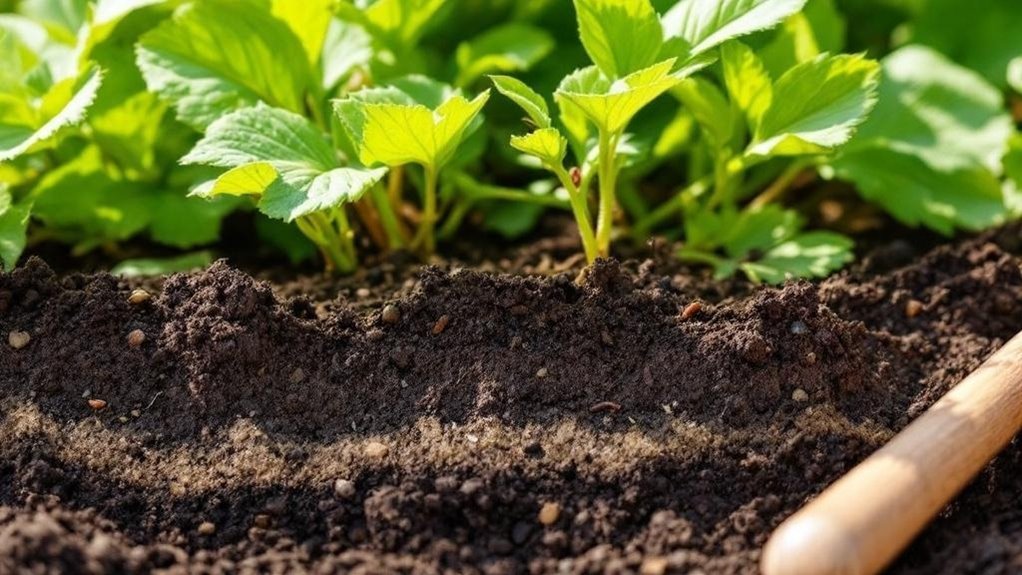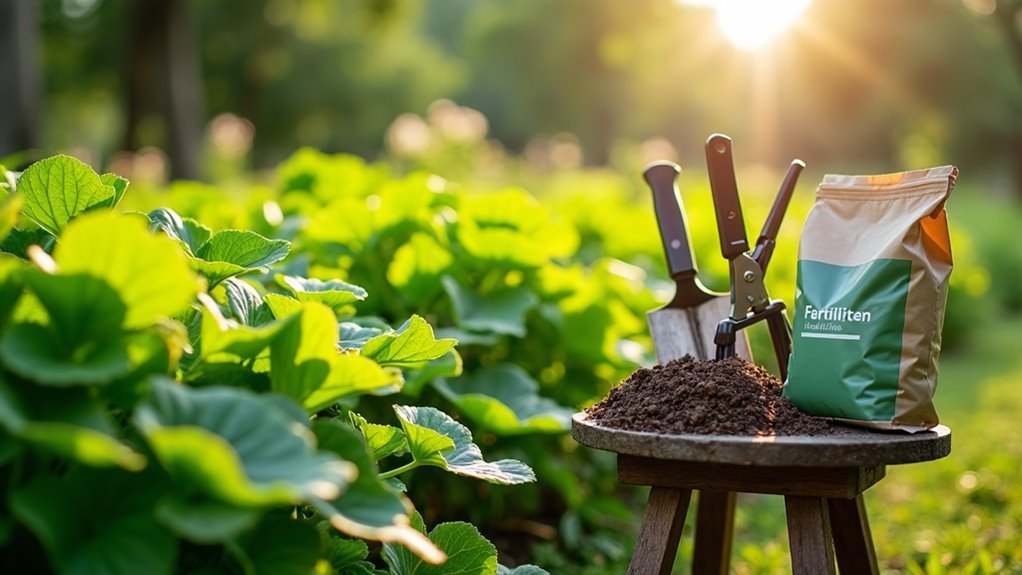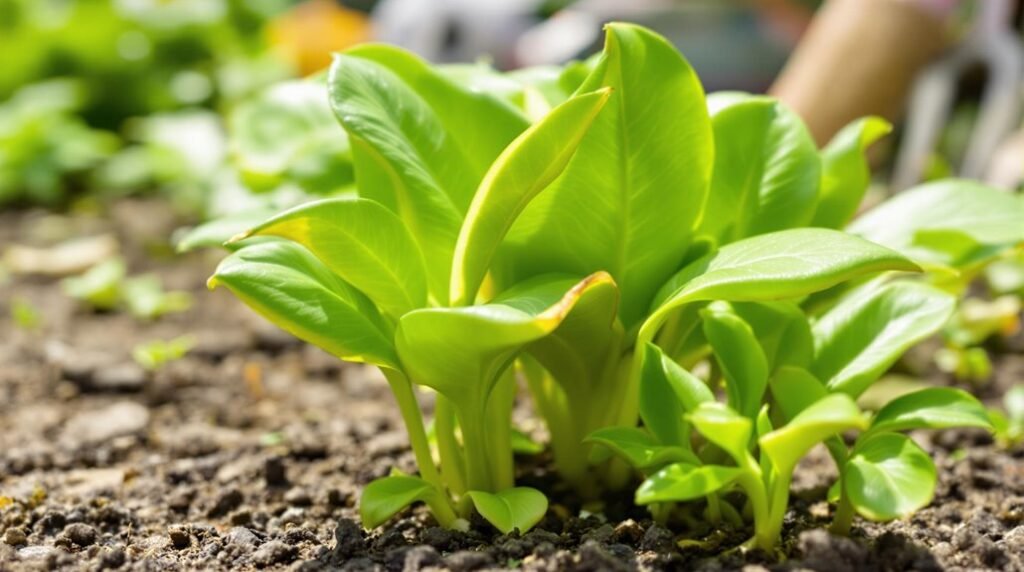If your plant isn’t flowering, you might be wondering what’s holding it back. It’s not always obvious—sometimes it’s about how old the plant is, or if it’s getting the right amount of sunlight. Soil quality and nutrient balance can also play a big role. Before you consider starting over, understanding these factors can help you identify the real issue and take the right steps to encourage blooms.
Understanding Plant Maturity and Blooming Cycles
Although it can be frustrating when your plants don’t flower, understanding their maturity and blooming cycles is key to patience and success. Many plants need 2-3 years to mature before they start blooming, so if your plant is young, it might simply need more time.
Patience is essential—many plants require 2-3 years to mature before blooming beautifully.
Grafted plants add complexity—depending on the rootstock’s age and type, flowering can vary. Some species, like certain fruit trees, bloom only every other year, so don’t expect yearly flowers.
Remember, young plants often won’t bloom because they haven’t reached full maturity yet. While environmental factors also play a role, focusing on your plant’s age and natural cycle helps set realistic expectations.
Give your plants the time they need, and you’ll be rewarded with beautiful blooms eventually.
Assessing Light and Sun Exposure Needs
How much light does your plant really need to thrive and bloom? Light exposure plays an essential role in flower production, so you must match your plant’s needs with its environment.
Most flowering plants need 6-8 hours of direct sunlight daily. Here’s how to evaluate light and sun exposure:
- Check plant labels for specific light requirements.
- Place sun-loving plants in areas with ample morning sunlight to dry dew and reduce disease risk.
- Avoid shaded spots for sun-loving varieties; too much sun can stress shade-tolerant plants, reducing blooms.
- Monitor seasonal changes and nearby obstructions like trees or buildings that may block light exposure.
Regularly evaluating these factors guarantees your plants get the right light intensity to encourage healthy flowering.
Evaluating Soil Health and Composition

Since soil health directly impacts your plant’s ability to grow and bloom, evaluating its composition is essential. Start by conducting a soil test to determine pH levels, nutrient content, and organic matter.
Most flowering plants thrive in well-drained loamy soil, so if you have heavy clay or sandy soil, consider adding compost or organic matter like rotted manure or pine fines to improve texture and fertility. These amendments boost nutrient availability and moisture retention, supporting healthier roots and more vibrant blooms.
Understanding your soil type helps you tailor care to your plant’s needs, ensuring ideal growth conditions. Regular soil testing keeps you informed about changes in soil health, letting you adjust your approach before flowering problems arise.
Identifying Nutrient Imbalances Affecting Flowers
When your plants fail to flower, nutrient imbalances often play a key role. One common culprit is excess nitrogen, which encourages lush foliage but suppresses blooms.
To identify these imbalances, consider these points:
- Check for excess nitrogen causing abundant leaves but few flowers.
- Test soil phosphorus levels, as low phosphorus inhibits flowering.
- Confirm potassium is adequate to strengthen stems and boost disease resistance.
- Conduct regular soil tests to pinpoint nutrient deficiencies or surpluses.
Correcting Over-Fertilization Issues

Although over-fertilization can make your plants look healthy with abundant foliage, it often prevents them from flowering properly. Excess nitrogen encourages leafy growth but inhibits blooms.
To correct over-fertilization, start by testing your soil to identify nutrient imbalances. Then, switch to a phosphorus-rich fertilizer to encourage rooting, fruiting, and flowering, which helps counteract the excess nitrogen.
Water your plants more frequently to leach out surplus nutrients, reducing over-fertilization’s negative effects. Keep an eye out for fertilizer burn signs like yellowing leaves or stunted growth and adjust your fertilizing routine accordingly.
Choosing the Ideal Planting Location
Choosing the ideal planting location involves considering several key factors to guarantee your plants thrive and bloom beautifully.
First, make certain your plants get enough light—6 to 8 hours of direct sunlight daily is crucial for most flowering species.
Next, check the soil type; well-drained loamy soil that holds moisture without flooding is best.
Third, match the spot’s temperature to your plants’ preferences, avoiding extreme cold or heat that can stunt flowering.
Finally, provide enough space between plants to guarantee good air circulation and reduce nutrient competition.
Here’s a quick checklist:
- Confirm 6-8 hours of direct sunlight for enough light
- Choose well-drained, loamy soil
- Select an area matching temperature needs
- Space plants adequately for airflow and nutrient access
This careful site selection sets the stage for vibrant blooms.
Implementing Proper Planting Techniques
After selecting the perfect spot for your plants, the next step is to focus on proper planting techniques to guarantee they establish well and bloom as expected.
Start by planting at the correct depth—usually, the root ball should be level with the surrounding soil to avoid root and moisture issues. Remember, plants need adequate spacing to guarantee good air circulation, reducing disease risk and promoting healthier flowers.
Plant at the right depth and space properly to ensure healthy roots and vibrant blooms.
Loosen the soil and mix in compost to create a fertile environment that supports growth. Consistent moisture is essential, especially during dry spells, as plants need steady hydration to prevent stress that can inhibit flowering.
Finally, consider each plant’s unique light and soil requirements to optimize placement and guarantee they thrive.
Pruning Practices to Encourage Flowering
When you prune your plants correctly, you encourage more abundant and healthier flowering. Effective pruning practices help your plants focus energy on producing blooms rather than seeds or damaged growth.
To get the best results, follow these key steps:
- Identify if your plant blooms on old wood or new growth to time pruning properly.
- Deadhead spent flowers regularly to prevent seed setting and promote new blooms.
- Use sharp, clean tools for precise cuts that reduce plant stress and disease risk.
- Prune spring-flowering shrubs right after they bloom to avoid cutting off next year’s buds.
Managing Watering and Environmental Stressors
Pruning sets the stage for your plants to bloom, but managing watering and environmental stressors keeps those buds healthy and thriving.
You need to monitor soil moisture closely because both overwatering and underwatering stress plants, preventing flowers from developing. Container plants often demand daily watering, especially in hot weather when soil dries rapidly.
Environmental factors like heat waves or prolonged rain can cause buds to drop, so adjust your watering accordingly. To reduce heat stress, water your plants in the cooler morning hours, helping them recover from midday wilt.
Enhancing Pollination for Better Blooming
How can you boost your garden’s flowering potential? Enhancing pollination is key. Pollinators like bees and butterflies play a vital role in flower production, so attracting and supporting them is important.
You can take these steps to improve pollination:
- Plant native flowers and provide habitats such as bee hotels and water sources to encourage diverse pollinators.
- Use hand pollination for plants lacking specific pollinators or during bad weather.
- Create windbreaks or choose sheltered spots to protect pollinators from cold or wind.
- Maintain a healthy ecosystem and grow blooming species that attract pollinators across seasons.
Frequently Asked Questions
What to Do if Your Plants Are Not Blooming?
If your plants aren’t blooming, check they get 6-8 hours of sunlight, avoid overwatering, use phosphorus-rich fertilizer, prune properly, and be patient—some plants need time to mature before flowering consistently.
What Does It Mean When Flowers Don’t Bloom?
When flowers don’t bloom, it means your plant might lack enough sunlight, nutrients, or proper care. It could also be too young or stressed by environmental factors. You’ll need to adjust these conditions to encourage blooming.
Why Aren’t My Plants Producing Flowers?
Your plants might not be flowering because they’re not getting enough sunlight, receiving too much nitrogen, experiencing stress from extreme weather, or you’re pruning at the wrong time. Also, younger plants often need more time to mature.
How to Encourage Flowering in Plants?
You’ll encourage flowering by giving plants 6-8 hours of sunlight, using balanced fertilizer with phosphorus, watering consistently, deadheading spent blooms, and pruning properly. Avoid overwatering and excess nitrogen to help your plants bloom beautifully.
Final Thoughts
If your plants aren’t flowering, don’t worry—you’re not alone. Did you know that nearly 60% of gardeners struggle with blooms due to improper light or nutrient balance? By ensuring your plants get 6-8 hours of sunlight, checking soil health, and adjusting fertilization—especially phosphorus—you can boost flowering success. Remember, patience and proper care pay off. Follow these tips, and you’ll soon enjoy a vibrant, blooming garden that’s worth the wait!
